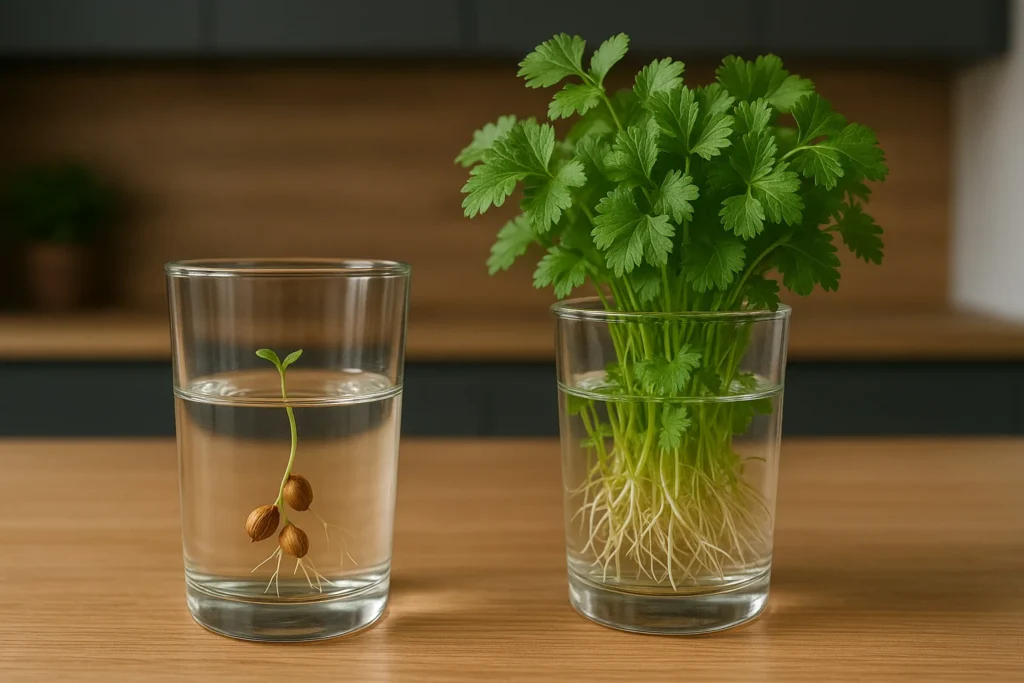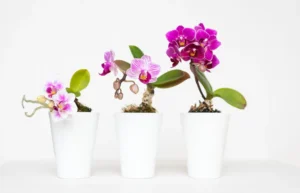
Coriander, also known as Chinese parsley, is one of those aromatic plants that arouses conflicting opinions: some love him for his freshness and his exotic aroma, while others find that his perfume remember soap. But regardless of one’s opinion, there is no doubt that coriander is a fundamental ingredient in many kitchens in the world: from the Mexican to Indian, from the Thai to the Vietnamese one. Thanks to its particular culinary properties, it is becoming increasingly popular in all homes.
Good news? Coriander You no longer need to look for your meals in supermarkets. With few basic materials and the right process, you can grow it directly at your home – without land, only in water. This method is not only comfortable but also sustainable, since it allows you to have a regular harvest of fresh leaves without unnecessary waste and without pesticides. In the following article we offer you a detailed guide on how to grow coriander in the water, even if you don’t have much experience with plants.
Everything you need for fresh coriander:
- coriander seeds (they can also be culinary, but it is better to sow them for gardening)
- Glass container or small jar Without drainage holes
- Clean water (ideally filtered)
- A bright window sill or another source of natural light
- A (not too too) patient approach
Step by step: how to grow coriander in water
1. Choose the right container
For this type of hydroponic cultivation (i.e. without earth), it is essential to choose a container without drainage holes. Smaller glass or plastic containers are ideal, as they allow you to observe the roots and control the water level. It is also important to thoroughly clean the container before use, since residues of dirt or microorganisms can inhibit germination or damage young sprouts.


2. The soaking of the seeds: prerequisite for a successful germination
The coriander seeds have a hard shell, so it is recommended to immerse them in water for about 24 hours before planting them. This process softens the external layer of the seed, allowing water to penetrate more easily and activating the processes necessary for germination. You can immerse the seeds directly in the container where you think you can grow them later or use a separate bottle.
3. Put the seeds in the water
After soaking, you can carefully transfer the seeds to the container with the water you have chosen. It is important that the seeds do not float freely on the surface, but they are just below it, since to successfully germinate they must have constant contact with water. If necessary, push them gently downwards or use a thin layer of sterilized gauze to keep the seeds stop.
4. Light as a growth engine
Coriander needs at least 4-6 hours of direct sunlight per day. The best choice is a sunny windows of south or south-west. If you do not have this lighting, you can also use LED lights for plants that simulate daytime light. Light directly influences photosynthesis and therefore the growth and aromaticity of the leaves.
5. Keep the water level
During germination and the initial growth phase, it is essential that the seeds and subsequently the roots are always immersed in the water. The water must be at room temperature, preferably filtered or boiled and cooled. It is recommended to check the water conditions every few days: if it becomes cloudy or has an unpleasant smell, replace it. A plant full of freshness grows only in completely sweet water.
See also


6. First sprouts and growth
Germination usually takes place within 7-14 days. When the first shoots appear it is a sign that the plant is fine. After germination, it is important to continue to provide the plant to the light enough and maintain a stable micro -food. If you notice signs of rot (for example brunastre roots or an unpleasant smell), it is necessary to intervene immediately by changing the water and possibly removing the damaged parts.
7. Collection – At the right time
When the plant reaches a height of about 10-15 cm and develops larger leaves, it is ready for the first harvest. Collect the leaves gradually, always from the outside to the inside, to stimulate more intense growth. It is important not to remove more than a third of the plant at a time, since this reduces its regeneration capacity.
8. Regular care and renewal of crops
For long-term cultivation, we recommend starting a new germination cycle every 2-3 weeks, in order to always have a fresh escort. If you notice that the plant is starting to flourish (it produces small white flowers), it removes it as soon as possible: flowering means that the plant is heading towards the end of its life cycle and will stop producing leaves.


Tips for advanced cultivation of coriander
- Use varieties of biological and non -germinated seeds To obtain the best taste and the best growth.
- Garza or fine jersey It can be used as a support to maintain seeds under water without submerging them completely.
- Water change every 10-14 days It will prevent the development of algae and bacteria and maintain a stable environment.
- Use of LED lights During the winter months it can significantly extend the growth season.
Conclusion: cultivate coriander in the house: an aromatic and sustainable decision
Cultivating coriander in the house, simply in water, is surprisingly easy and accessible even to absolute beginners. It allows you to produce a regular harvest of fresh and aromatic leaves without the need for earth or complex systems. It also represents a sustainable solution for anyone who wants to reduce their environmental impact and at the same time diversify their dishes with their own production vegetables. By following the steps described, you too can create your mini oasis of aromatic herbs in a few weeks, without garden and without stress.





